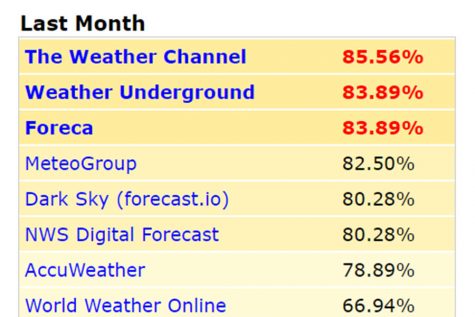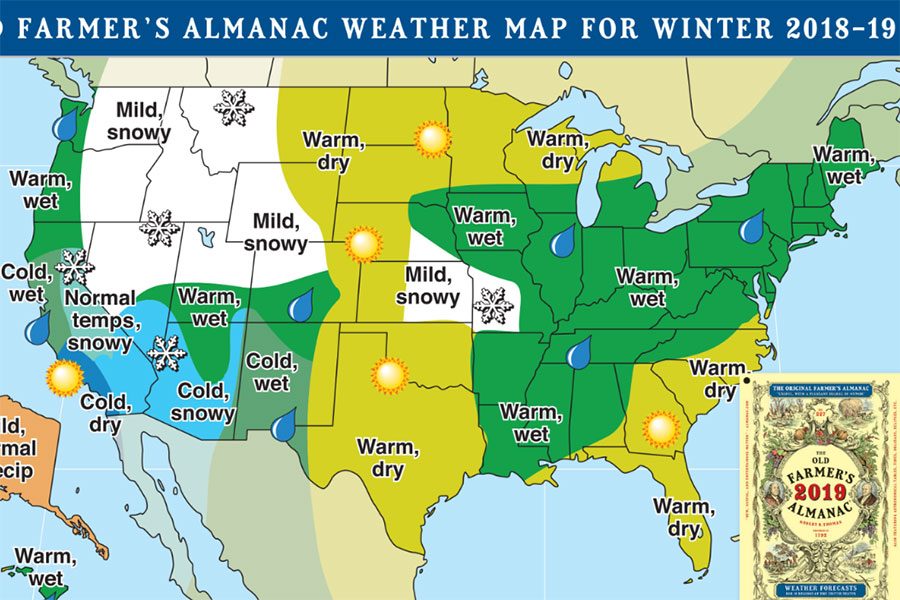Does this weather predictor put weathermen everywhere to shame?
From the Farmers Almanac website, this map of the US shows its predictions for the 2018-2019 winter, warm and wet. Not very wintery but at least it’s not absolutely freezing cold.
January 8, 2019
As seasoned New Englanders, most of us know to hunker down and suffer through the bitter cold winds and heavy snow falls winter loves to bring us. We look at weather apps on our phones, watch the news and everything in between to try and find out what mother nature has in store for us. Could the answer to all of our winter weather inquiries be answered by a 200 year old math equation?
The Farmers’ Almanac is a mathematical equation of sorts that allows long range predictions that are eerily accurate. It’s been around longer than the National Weather Service, coming about in 1792 due to the work of one of it’s first editors, Robert B. Thomas. Although this was not the first almanac, which by definition records and predicts astronomical events, it became insanely popular. By the second year, it’s circulation shot up from 3,000 to 9,000 copies sold.
Thomas observed a series of complex natural cycles and used them to devise the formula which can predict the weather with an amazing 80 percent accuracy.
This is close to home for us Granite Staters, seeing as how the secret formula, available only to select editors, is kept right here in NH! The book is “safely tucked away in a black tin box at the Almanac offices” located in Dublin, says the Farmers’ Almanac website.
Looking back at last year’s forecast from our farmer friends can give us an insight into how accurate it really is. Published in mid 2017, the weather predictions were as follows: overall milder temperatures, but colder than 2016’s winter. A mix between snow and rain throughout, and precipitation will be above normal across the US. Now let’s see, if we take a look at the official release of what last winter actually was like, according to Climate.gov we did indeed have a milder than normal winter with above average precipitation across the country. You can’t ignore that accuracy, can you?
You could argue the almanac is a better source objectively, when looking at its bias. When weather channels present you their information, their accuracy can sometimes be compromised by an incentive to achieve high ratings. There are many channels to choose from for weather so they rush to get the information out, making it interesting to watch so people stay tuned in. “[The Almanac] is not trying to gain any media attention, they aren’t angling for ratings like the weather channel, they don’t gain anything from that, they profit from providing straightforward reliable information to people,” said Lucien Boudreau ‘19, a reader of the almanac.
However, it’s the best source for the everyday person looking at the weather, trying to find out if they should wear pants or shorts. “The Almanac is good for seeing what winter has for us overall, and it proves to be very useful, but not so much for day to day weather and that’s what most people look for,” said Camille Carson, the AP Environmental Science teacher at HBHS.
The Farmer’s Almanac is great if you want a small insight into what winter will be like, and it’s quite probable that it will be accurate, but it’s not practical for day-to-day predictions. Even if the weather channels create hype and shock around how they present their information, it’s more useful when looking for specifics, like daily temperatures and specific dates for storms.

A snapshot from the Forecast Advisor website, this chart shows how accurate the listed weather sources are based off of Manchester New Hampshire. Choose your provider wisely!
Looking ahead, we can get a basic understanding of the weather for January from the renowned almanac. For example, the weather this winter has been anything but normal: snow one day then 65 the next. Sleet, hail, and freezing rain have all shown their faces. And, unfortunately, for all you snow day lovers, our friends at the Almanac offices predict a fairly mild winter with more rain than anything. Not as many days will be spent building snowmen and sipping hot cocoa as you may like. Don’t lose hope! January is when we’ll be seeing the snow, just not as much as in past years.
Realistically, you shouldn’t solely rely on the Farmer’s Almanac for weather, but reading the Almanac gives a nice insight over all, and it’s definitely a good source for long term information. the past something something something to do w your article. The Forecast Advisor website is one example of a website that allows you to enter your zip code and see how accurate different weather providers are in your area, in the past month as well as in the past year.














